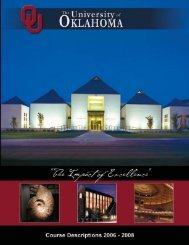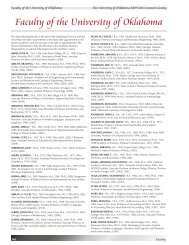Atmospheric and Geographic Sciences (AGSC)The Uni ver sity <strong>of</strong> <strong>Oklahoma</strong> <strong>2006</strong>-20<strong>08</strong> Gen eral Cat a log3190 Topics in Astronomy. 1 to 3 hours. Prerequisite: permission <strong>of</strong>instructor. May be repeated with change <strong>of</strong> subject matter; maximumcredit nine hours. (F, Su)3990 Independent Study. 1 to 3 hours. Prerequisite: one course in generalarea to be studied; permission <strong>of</strong> instructor and department. May berepeated; maximum credit six hours. Contracted independent study for topicnot currently <strong>of</strong>fered in regularly scheduled courses. Independent studymay include library and/or laboratory research and field projects. (Sp, Su)G4303 Stellar Astrophysics. Prerequisite: 3113 or permission <strong>of</strong> instructor.Physics <strong>of</strong> stars: gas and radiation laws, stellar atmospheres and spectra,stellar interiors and evolution. (F)4990 Independent Study. 1 to 3 hours. Prerequisite: three courses in generalarea to be studied; permission <strong>of</strong> instructor and department. May berepeated; maximum credit six hours. Contracted independent study fortopic not currently <strong>of</strong>fered in regularly scheduled courses. Independentstudy may include library and/or laboratory research and field projects. (F,Sp, Su)G5403 High-Energy Astrophysics. Prerequisite: 4303 or permission <strong>of</strong>instructor. High-energy radiation processes in astronomy: synchrotronradiation, bremsstrahlung, inverse Compton-effect. New wavebands <strong>of</strong>observation, UV, X-ray and gamma-ray astronomy. Radioastronomy:supernova remnants, pulsars, neutron stars. Radiogalaxies, active galacticnuclei, quasars. Theories <strong>of</strong> the origin <strong>of</strong> cosmic rays. (Irreg.)G5443 Galactic Astronomy. Prerequisite: 4303 or permission <strong>of</strong> instructor.Basic properties <strong>of</strong> galaxies are explored with special focus on the MilkyWay. Topics include galaxy classification and morphology, stellarpopulations, clusters and kinematics, interstellar medium, distributions <strong>of</strong>mass and light, spiral structure, chemical evolution, systemic rotation andgalaxy mass, and distance-determining methods. (Irreg.)G5453 Extragalactic Astronomy and Cosmology. Prerequisite: 3113 or4303 or permission <strong>of</strong> instructor. Basic properties <strong>of</strong> stars. Review <strong>of</strong>observational tools for extragalactic work. Stellar content and interstellarmedium in normal galaxies. Introduction to the theory <strong>of</strong> Big Bang cosmology.Comparison <strong>of</strong> observational data to cosmological predictions. Theextragalactic distance scale and the age <strong>of</strong> the universe. Large scale structure:galaxy clusters and superclusters. Active galaxies—radio galaxies and quasars.(Irreg.)G5463 Stellar Atmospheres. Prerequisite: 4303 or permission <strong>of</strong>instructor. Local thermodynamic equilibrium. Radiative transfer, continuousabsorption coefficient and model stellar atmospheres. Atomic andmolecular spectroscopy and the quantitative analysis <strong>of</strong> stellar spectra.Atomic processes and departures from local thermodynamic equilibrium.Extended and expanding atmospheres, novae, supernovae. (Irreg.)G5473 Stellar Interiors. Prerequisite: 4303 or permission <strong>of</strong> instructor.Evolution and energy balance <strong>of</strong> stars including gravitational attraction,nucleosynthesis, radiative and convective energy, transport andequilibrium, construction <strong>of</strong> stellar models for pre-main sequence andmain sequence stars, and the theory <strong>of</strong> giants and white dwarfs. (Irreg.)G5513 Interstellar Medium. Prerequisite: 4303 or permission. Processesin low-density media are explored, including the physics relevant toemission line objects such as HII and HI regions, molecular clouds, andactive galaxies. Techniques for deriving chemical abundances are explored,as are interstellar absorption by gas and dust and radiation transfer. (Irreg.)G5900 Seminar in Astrophysics. Prerequisite: permission <strong>of</strong> instructor.May be repeated with change <strong>of</strong> subject matter; maximum credit ninehours. A research seminar devoted to the study <strong>of</strong> specialized topics inastronomy and astrophysics. Topics selected will reflect the interest <strong>of</strong> theinstructor and students. (Irreg.)Atmospheric and GeographicSciences (AGSC)2004 Evolution <strong>of</strong> the Earth System. Overview <strong>of</strong> the earth from a systemsperspective. Draws on knowledge from all geosciences to exploreinterconnections and co-evolution <strong>of</strong> the solid earth, atmosphere, oceans,and living things. Evolution <strong>of</strong> the Earth’s climate over geologic timeincluding the hydrologic cycle, carbon, cycle and “greenhouse effect”. Roleliving things play in the global environment. Extensive use <strong>of</strong> numericalmodels to explore structure and response <strong>of</strong> the Earth system. Studentsmay find it helpful to have taken either Geography 1114, or Geology 1104,or Meteorology 1014. Laboratory (F) [II-LAB]2014 The Earth System. An integrated overview <strong>of</strong> earth sciencesemphasizing earth materials, the oceans and atmosphere, the solar system,and earth’s evolution. The interrelationship among the different earthsystems will be emphasized. Topics will be explored through alearning-cycle approach. The lab component includes both in-classexperiments and one field-based research project. Laboratory (Sp) [II-LAB]3960 Honors Reading. 1 to 3 hours. Prerequisite: admission to HonorsProgram. May be repeated; maximum credit six hours. Consists <strong>of</strong> topicsdesignated by the instructor in keeping with the student’s major program.Covers topics not usually presented in the regular courses.3970 Honors Seminar. 1 to 3 hours. Prerequisite: admission to HonorsProgram. May be repeated; maximum credit six hours. Subjects coveredvary. Deals with concepts not usually treated in regular courses.3980 Honors Research. 1 to 3 hours. Prerequisite: admission to HonorsProgram. May be repeated; maximum credit six hours. Provides anopportunity for the gifted honors candidate to work at a special project inthe student’s field.G4970 Seminar. 1 to 9 hours. Prerequisite: permission <strong>of</strong> instructor. Maybe repeated with change <strong>of</strong> subject matter; maximum credit nine hours.Subjects covered vary. Deals with interdisciplinary concepts in geosciencesnot usually treated in regular courses. (Irreg.)4990 Special Studies. 1 to 4 hours. Prerequisite: Permission <strong>of</strong> instructor,upper-division standing. Contracted special problems study for topics notcurrently <strong>of</strong>fered in regularly scheduled courses; may include library and/orlaboratory research and field projects.G5510 Selected Topics. 1 to 9 hours. Prerequisite: permission <strong>of</strong> instructor.May be repeated; maximum credit nine hours. Current or special topicsrelating to the geosciences; may be structured for students in other areas.(Irreg.)G5823 Heat Flow. Prerequisite: Geology 3114, Mathematics 2423, andPhysics 2524. Terrestrial heat flow and thermal aspects <strong>of</strong> geologicprocesses. Fourier’s law <strong>of</strong> heat conduction, diffusion equation, thermalproperties <strong>of</strong> earth materials, laboratory and field methods, terraincorrections. Fluid flow and heat transport in the continental crust. Thermalevolution <strong>of</strong> sedimentary basins, hydrocarbon maturation, climate changefrom borehole temperature pr<strong>of</strong>iles. (F)Aviation (AVIA)1003 Introduction to Computer Concepts and Applications.Prerequisite: permission <strong>of</strong> instructor. Students learn to navigate inWindows, Micros<strong>of</strong>t Office: Word, Excel, PowerPoint, Access and Outlook.(F, Sp, Su)1013 Introduction to Air Traffic Control. The purpose <strong>of</strong> this course is tolearn about the air traffic control system from both the pilot andcontroller’s perspectives. This course is the first <strong>of</strong> six courses for the ATCminor and a prerequisite for basic air traffic control regulations. (F, Sp)1113 Introduction to Aviation. Prepares student to take the FAA privatepilot written examination. Covers FAR’s, meteorology, aerodynamics, flightphysiology, performance charts, radio navigation techniques. (F, Sp, Su)1213 Basic Air Traffic Control Regulations. Prerequisite: 1013. Thiscourse is a progressive continuation <strong>of</strong> introduction to air traffic control anda prerequisite for general air traffic control procedures. This course is morenarrowly focused on study and interpretation <strong>of</strong> the FAA orders andregulations that govern the air traffic control system and the nationalairspace system. (F, Sp)1222 Primary Flying. Prerequisite: 1113. Includes in-flight instruction witheffort directed toward obtaining FAA certification as a private pilot. Thirdclass medical must be obtained prior to solo. (F, Sp, Su)2013 General Air Traffic Control Procedures. Prerequisite: 1213. Thiscourse will present the study <strong>of</strong> “general control” procedures used in theterminal and en route control options as well as FAA flight service processesand procedures. This course will serve as a prerequisite for airport trafficcontrol procedures. (F, Sp)2231 Advanced Flying. Prerequisite: 1222 or private pilot certificate. (F,Sp, Su)29 <strong>Course</strong> <strong>Descriptions</strong>
The Uni ver sity <strong>of</strong> <strong>Oklahoma</strong> <strong>2006</strong>-20<strong>08</strong> Gen eral Cat a logAviation (AVIA)2341 Secondary Flying. Prerequisite: 2231. Consists <strong>of</strong> cross-countryexperience under the direct supervision <strong>of</strong> an instructor pilot. Part <strong>of</strong> theFAA Part 141 commercial certification course. (F, Sp, Su)2513 The History <strong>of</strong> Aviation. Chronicles the history <strong>of</strong> aviation throughan in-depth study <strong>of</strong> powered flight and focus on the development <strong>of</strong> civil,commercial, and military aviation. The course will cover significant eventsand people throughout aviation history from the first powered flightthrough present day developments and a brief look into the future. Alsoexamines the impact <strong>of</strong> aviation on recreation, transportation, warfare, andexploration. (F, Sp)2613 Aviation Safety. Prerequisite: 1113 and 1222. This course willexamine all aspects <strong>of</strong> accidents/incidents involving airline and generalaviation flights. It examines those areas from the perspective <strong>of</strong> pilots, crewmembers, air traffic controllers and National Transportation Safety Board(NTSB) findings. Each accident/incident is dissected with the goal <strong>of</strong>determining what went wrong and lessons that can be learned. (F, Sp)3013 Career Development for Aviation Pr<strong>of</strong>essionals. Prerequisite:completed 36 or more college credit hours. This course will provide anoverview <strong>of</strong> the career planning process for aviation students. Students willmaster the techniques <strong>of</strong> self-assessment, resume and letter writing,interviewing, researching companies, proper writing techniques, ethics andetiquette, and networking. This course is intended to help students preparefor internship interviews or entering the aviation industry as a pr<strong>of</strong>essional.(F, Sp)3103 Flight Deck Environmental Issues. Prerequisite: departmentalpermission. Human-machine interface issues in today’s modern flight deckare the focus <strong>of</strong> the course. Leading to that end, the student will explorethe cognitive and psychomotor domains <strong>of</strong> learning, review studies <strong>of</strong>aircrew interface problems, learn coping mechanisms used by today’s bestaviation trainers to overcome design-induced problems in cockpitadvanced technology. (F, Sp, Su)3111 Advanced Flight Maneuvers. Prerequisite: 1222 or FAA private pilotcertificate. Increase the student’s knowledge and understanding <strong>of</strong>advanced flight maneuvers. Accelerated stalls, spins, inverted flight, andrecovery from unusual altitudes. Advanced aerodynamics will be discussedand demonstrated. (F, Sp, Su)3113 Commercial Aviation. Prerequisite: 1113 or private pilot certificate.To define the scope and narrow the field <strong>of</strong> study, ins<strong>of</strong>ar as possible, to theknowledge requisite to the commercial pilot certificate. (F, Sp, Su)3133 Fundamentals <strong>of</strong> Instrument Flight. Federal aviation regulations aspertain to instrument flight rules, (IFR) weather and forecast products,interpretation <strong>of</strong> en route low altitude charts and terminal instrumentapproach procedure depictions, instrument flight procedures andtechniques. (F, Sp, Su)3213 Airport Traffic Procedures. Prerequisite: 2013. The primary focus <strong>of</strong>this course is to study visual air traffic control procedures, specifically, tolearn the principles <strong>of</strong> operation and the separation methods required inthe air traffic control tower environment. This course will serve as aprerequisite for IFR Air Traffic Control Procedures. (F, Sp)3313 IFR Air Traffic Procedures. Prerequisite: 3213. <strong>Course</strong> focuses onthe requirements and procedures used in the IFR air traffic controlenvironment. The students will study all <strong>of</strong> the separation standards andrules used in radar and non-radar environments in the approach controland air route traffic control facilities. This course will serve as a prerequisitefor Air Traffic Simulation. (F, Sp)3333 Survey <strong>of</strong> Aviation Law. Prerequisite: 1113 or junior standing.Survey <strong>of</strong> legal issues in aviation. The student will review legislation,regulatory agencies, and case studies dealing with legal issues in themedium <strong>of</strong> airspace above the ground-predominantly over the UnitedStates. The student will be able to identify and comprehend the historicalevents and technical terms that describe national and international legalprecedents that have shaped aviation law. (F, Sp)3513 Airport Operations Management. Prerequisite: 1222. Provides thestudent with an in-depth analysis <strong>of</strong> airport management, operations andplanning functions necessary to operate, develop, and maintain safe andefficient airport facilities as is the practice in the United States. Alsointroduces air traffic control (ATC) concepts. (F)3572 Instrument Flying. Prerequisite: 3133 and private pilot certificate.Individual flight simulator instruction in the technique <strong>of</strong> flying solely byreference to instruments. Ground instruction in radio navigation,meteorology, instrument approach procedures, air traffic controlprocedures and federal aviation regulations. (F, Sp, Su)3581 Multi-engine Flying. Prerequisite: 4552 or commercial pilotcertificate. A study <strong>of</strong> the design, construction and flight characteristics <strong>of</strong>multiengine aircraft. Inflight instruction in pilotage and operation <strong>of</strong>multiengine airplanes. Designed to qualify the student for certification as amultiengine pilot. (F, Sp, Su)3591 Flight Management Systems. Prerequisite: 4552 and permission <strong>of</strong>department. The programming and operation <strong>of</strong> a typical turbine aircraftsystem. Instructor uses PC-based program to demonstrate programmingand operation <strong>of</strong> the flight management systems used in modern corporate,regional, and major airline aircraft. Students are expected to master theprogram using the system. (F, Sp, Su)4015 Air Traffic Simulation. Prerequisite: 3313. Lab to prepare student foron-the-job training in an FAA air traffic control facility. <strong>Course</strong> will consist<strong>of</strong> dynamic simulation exercises in an ATC computer lab as well asclassroom briefings. Students will run scenarios as the controller and as apseudo pilot. (F, Sp)4113 CFI Seminar. Prerequisite: 3133, 3113. Increase student knowledge<strong>of</strong> theories <strong>of</strong> learning, flight instructor authority, and responsibility andclassroom and flight techniques. Emphasis on principles <strong>of</strong> instruction,student motivation and maneuver error analysis. (F, Sp, Su)4313 Turbine Transition. Prerequisite: 3581 and 4552. Introduce thestudent to the procedures <strong>of</strong> flying a turbine aircraft and the concepts <strong>of</strong>crew resource management. Emphasis is placed on the basic terminologyand procedures and emergency operations. (F, Sp, Su)4423 Crew Resource Management. Prerequisite: 3581 and 4552. Toteach the student the principles and procedures <strong>of</strong> a two or more personcockpit. Includes: briefings, call-outs, and emergency procedures. (F, Sp, Su)4552 Commercial Flying. Prerequisite: 3113. The final stage <strong>of</strong> the FAAPart 141 commercial pilot certification course. Designed to polish pilotskills in commercial aircraft maneuvers.(F, Sp, Su)4602 Flight Instructor—Airplane. Prerequisite: commercial pilotcertificate and instrument rating. Flight instruction in preparation for FAAflight instructor certificate. (F, Sp, Su)4613 Instrument Flight Instructor. Prerequisite: commercial pilotcertificate and flight instructor-airplane certificate. Consists <strong>of</strong> lecture andflight instruction in the specialized teaching techniques and proceduresrequired <strong>of</strong> an instrument flight instructor. At the end <strong>of</strong> the course, thestudent will meet the requirements for certification by the FAA as aninstrument flight instructor. (F, Sp, Su)4622 Multiengine Flight Instructor. Prerequisite: commercial multienginepilot certificate and flight instructor—airplane certificate. Instruction in thespecialized teaching techniques and procedures required <strong>of</strong> a multiengineflight instructor. At the end <strong>of</strong> the course, the student will meet therequirements to take the flight test for certification by the FAA as amultiengine flight instructor. (F, Sp, Su)4713 Senior Capstone. Prerequisite: senior standing and permission <strong>of</strong>instructor; completion <strong>of</strong> all other major upper-division courses orconcurrent enrollment. This project course builds on the accumulatedknowledge from all courses to date. Lectures will cover problemidentification, analysis, generation <strong>of</strong> alternatives, cost/benefit studies,interviews and presentations. Student teams will analyze and makerecommendations on an actual problem for an aviation relatedorganization, such as the FAA. (F, Sp, Su) [V]G4983 Airline Management. Prerequisite: junior or graduate standing.Study <strong>of</strong> the managerial aspects <strong>of</strong> the airline industry to include economicand organizational characteristics, marketing, operational scheduling, fleetplanning, and labor relations. Students participate in managementsimulation as senior executives <strong>of</strong> a regional domestic carrier. (F, Sp)4990 Special Studies in Aviation. 1 to 4 hours. Prerequisite: departmentalpermission. Will encompass various aviation-related topics including manyspecialty flight programs; such as, aerobatic instruction, multienginetraining, pilot refresher training, etc. (F, Sp, Su)G5113 Airport Operations and Management. Prerequisite: admission tograduate program in Aviation Management. Provides individuals with acomprehensive knowledge <strong>of</strong> the major facets in the process <strong>of</strong> planningand managing airports in the dynamic post-deregulation era. Students willfocus on operations, safety, security, community relations and development<strong>of</strong> the airport as a sound enterprise function <strong>of</strong> the United Statesgovernment. Discussions will focus on the history <strong>of</strong> the airport-airwaysystem, planning and funding in the airport, managing growth, and fiscaland administrative management processes. (Irreg.)<strong>Course</strong> <strong>Descriptions</strong> 30








